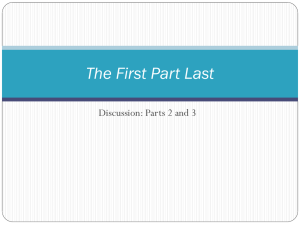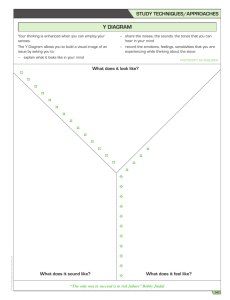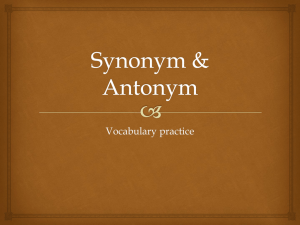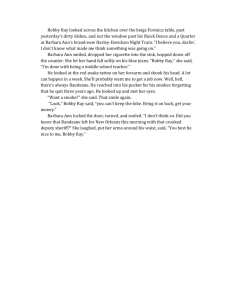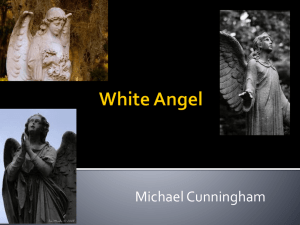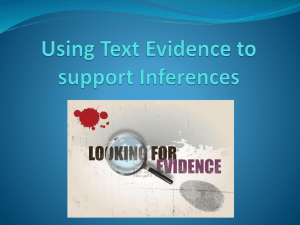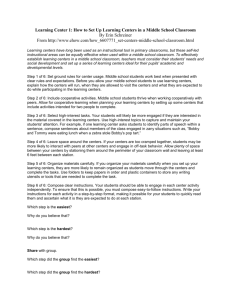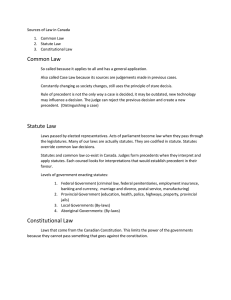chapter 4: finding the law: legal research
advertisement
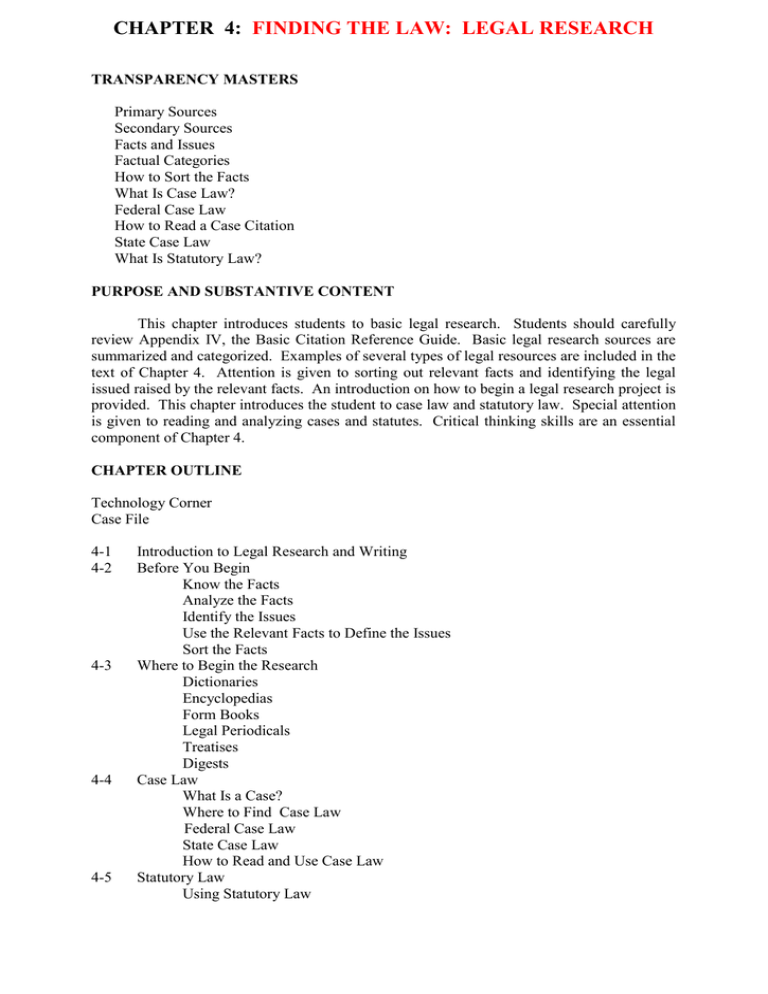
CHAPTER 4: FINDING THE LAW: LEGAL RESEARCH TRANSPARENCY MASTERS Primary Sources Secondary Sources Facts and Issues Factual Categories How to Sort the Facts What Is Case Law? Federal Case Law How to Read a Case Citation State Case Law What Is Statutory Law? PURPOSE AND SUBSTANTIVE CONTENT This chapter introduces students to basic legal research. Students should carefully review Appendix IV, the Basic Citation Reference Guide. Basic legal research sources are summarized and categorized. Examples of several types of legal resources are included in the text of Chapter 4. Attention is given to sorting out relevant facts and identifying the legal issued raised by the relevant facts. An introduction on how to begin a legal research project is provided. This chapter introduces the student to case law and statutory law. Special attention is given to reading and analyzing cases and statutes. Critical thinking skills are an essential component of Chapter 4. CHAPTER OUTLINE Technology Corner Case File 4-1 4-2 4-3 4-4 4-5 Introduction to Legal Research and Writing Before You Begin Know the Facts Analyze the Facts Identify the Issues Use the Relevant Facts to Define the Issues Sort the Facts Where to Begin the Research Dictionaries Encyclopedias Form Books Legal Periodicals Treatises Digests Case Law What Is a Case? Where to Find Case Law Federal Case Law State Case Law How to Read and Use Case Law Statutory Law Using Statutory Law Featured Website Chapter Summary Terms to Remember Questions for Review Questions for Analysis Assignments and Projects SKILL BUILDING The examples, assignments, case questions, and projects provide the opportunity for students to build the following skills: Critical Thinking Critical Analysis Legal Reasoning Basic Legal Research Basic Legal Writing Computer CASE SUMMARIES, CASE QUESTIONS, AND SUGGESTED ANSWERS In re Marriage of Modnick, 33 Cal. 3d 897, 191 Cal. Rptr. 629, 663 P.2d 187 (1983) (Pg. 79) Modnick is a family law/domestic relations decision. The legal issue addressed is “does the failure of one spouse to disclose the existence of a community property asset constitute extrinsic fraud?” When the Modnicks dissolved their marriage Mr. Modnick disclosed only one bank account in his name, that account had a $7.00 balance. After an IRS investigation Mrs. Modnick discovered that her former husband had willfully not disclosed other substantial bank accounts. She moved to set aside the final judgment. The trial court denied her motion. The appellate court reversed and vacated the interlocutory and final judgments of dissolution insofar as it related to the property settlement incorporated into the divorce decree and the spousal support award. Students are asked to compare and contrast the facts of the Modnick case with the facts of the hypothetical case presented in the Interoffice Memorandum that opens Chapter 4. 1. Compare the facts of the Modnick case with the facts of the Welch case provided in the memo to Terry Jacobs. What do the two cases have in common? How do the cases differ? Suggested Answer: Factual Similarities: Both cases involve family law. In each instance, one spouse intentionally hid assets from the other in an effort to avoid a more equitable split of the marital property. Factual Differences and Unknowns: In Modnick the spouse realized her former spouse hid bank accounts from her due to an IRS investigation into unreported income. In the Welch fact pattern the former business partner of the husband disclosed assets he was unaware the wife had no knowledge of. Child support is involved in the Welch situation and the former wife believes Mr. Welch’s income has increased. Modnicks were married for 22 years. The Note: Not all students will agree on what is a difference and what is an unknown. It is enough, at this stage, that they are able to support their reasoning. Some students will quickly realize that what is a similarity on one level may turn out to be a difference as the facts are further analyzed. Flexibility in evaluation of this assignment will help students build confidence in their analytical abilities. Learning to form analogies is an important element to be stressed in factual analysis. Listening to each other in a discussion format will prove beneficial for many students. 2. Are there additional facts you need to know in the Welch case in order to do a complete comparison with the Modnick case? If so, what do you need to know? Suggested Answer: Additional facts might include how much Mrs. Welch knew about her husband’s law practice; could she have easily uncovered the hidden assets; and why Mrs. Welch did not insist upon bifurcation of the property issues. Note: Answers here will vary. ETHICAL CHOICES You have completed the initial research in a contract case. You found several cases that clearly indicate that your client will not recover the damages he believes he incurred. What should you do? (Pg. 78) Points to Discuss: Is it ethical for an attorney to take a case when the law seems to be opposed to your client’s position? What obligation do you have to the court to tell it about law that does not favor your client? Do you have an ethical obligation to divulge the cases to anyone? QUESTIONS FOR ANALYSIS 1. Apply the North Carolina assault statute found in Section 4–5 to the following facts. a. Bobby is angry with his supervisor. He takes a gun to work, intending to scare his supervisor. He waves the gun around while yelling at the supervisor. The police are called. Officer Goodman approaches Bobby and asks for the weapon. Bobby accidentally fires the gun, injuring Officer Goodman in the hand. Did Bobby violate the assault statute? Explain your response. b. Bobby is angry with his supervisor. He takes a gun to work, intending to scare his supervisor. He stops at a local saloon to fortify himself for the confrontation with his supervisor. While Bobby is having a beer, the bartender notices the gun in Bobby’s coat. John Goodman, an off-duty security guard, is having coffee at a table. The bartender tells him about Bobby’s gun. Goodman approaches Bobby and asks for the weapon. Bobby accidentally fires the gun, injuring Goodman. Did Bobby violate the assault statute? Explain your response. Suggested Answer: (a) Bobby probably meeting all of the elements of the statute: 1. He committed an assault 2. He used a firearm 3. The assault was upon a law enforcement officer 4. The Officer was in the performance of his duties Suggested Answer: (b) Bobby did not violate the statute because it requires that the assault be on a law enforcement officer. Security guards are not normally law enforcement. 2. Summarize the factual dispute in Lorilland Tobacco Co. v. Reilly. The case syllabus (summary) is found in Appendix VII Suggested Answer: Massachusetts enacted legislation Governing the advertising and sale of tobacco products. The legislation included a ban on advertising within 1000 feet of a school or playground and required that point-of-sale advertising be placed no lower than 5 feet from the ground. A group of tobacco manufacturers and retailer filed suit claiming the laws violated the Supremacy Clause of the Constitution as well as the first and fourteenth amendments to the Constitution. Chapter 4: Finding the Law True/False 1. Primary sources include case law, statutes, constitutions, and dictionaries. 2. Encyclopedias are a secondary source. 3. An issue is a question that must be decided by a court. 4. Facts should be sorted into the following three categories: relevant, explanatory, and unnecessary. 5. Form books are filled with sample forms and explanations on how and when to use the forms. 6. A digest is an index to statutes. 7. Case law is a collection of reported cases. 8. Precedent is an example set by the decision of an earlier court for similar cases or similar legal questions which arise in later cases. 9. Statutes are laws enacted by the legislature. 10. The case brief is a short summary of a case. Multiple Choice 1. Which of the following are not secondary sources? a. b. c. d. e. treatises ordinances digests periodicals form books 2. Relevant facts are sometimes called: a. b. c. d. e. key facts focus facts explanatory facts important precedent 3. If you are unfamiliar with the area of law you are researching, you should begin the research with: a. b. c. d. e. case law statutes secondary sources primary sources newspapers 4. Some secondary sources are referred to as: a. b. c. d. e. annotations dictionaries finding tools research manuals indexes 5. Stare decisis(italicize?) means: a. b. c. d. e. case law reporter similarities precedent review 6. We look to statutes to provide: a. b. c. d. e. concise statements of the law a detailed summary of the law summaries of important cases guidance for the public references to secondary sources 7. Before comparing your facts and issues with case law, it is important you properly identify: a. b. c. d. e. important precedent facts and issues in your client’s situation judicial history the question presented explanatory facts 8. Information in a legal encyclopedia is arranged: a. b. c. d. e. alphabetically chronologically numerically randomly none of the above 9. Which of the following is an encyclopedia? a. Corpus Juris Secundum b. American Jurisprudence 2d c. California Jurisprudence 3d d. all of the above e. none of the above 10. The official reporter for U.S. Supreme Court cases is a. b. c. d. e. Supreme Court Reporter United States Reports Lawyer’s Edition The Supreme Court Web Site Westlaw Answer Key 1. False 7. True 2. True 8. True 3. True 9. True 4. True 10. True 5. True 6. False 1.b 7.d 2.a 8.a 3.c 9.d 4.c 10. ??? 5.d 6.a
